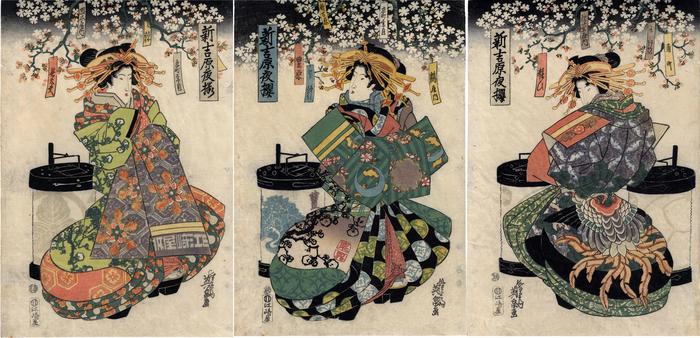Keisai Eisen (渓斎英泉) (artist 1790 – 1848)
Three panels from the series Cherry Blossoms at Night in the New Yoshiwara (Shin Yoshiwara yozakura - 新吉原夜桜) - Chōdayū (長太夫) of the Okamotoya on the left
ca 1823
30 in x 14.5 in (Overall dimensions) Japanese color woodblock print
Signed: Keisai Eisen ga
渓斉英泉画
Publisher: Ezakiya Kichibei (Marks 058 - seal 21-091)
Censor's seal: kiwame
Museum of Fine Arts, Boston - left panel only
Waseda University - right panel only
Google maps - Yoshiwara Shrine - one of the only signs of where this famous district was
Museum of Fine Arts, Boston - Utamaro of a beauty with a fan with the maru ni mitsu kashiwa motif
Tokyo Metropolitan Library - another late edition print from this series Originally we thought that these three panel formed a complete composition, but now we know that Robert Schaap and Glenn van den Bosch believe that two others were originally published with them. One can be seen in the Tokyo Metropolitan Library - see the link above - , published by the same house, but clearly of a much later edition. And since we haven't been able to find any other sheets from this series we now assume that this was actually a pentaptych.
****
Left Panel: This figure is Chōdayū (長太夫) of the Okamotoya (岡本屋). This oiran must have had quite a reputation because Eisen portrayed her more than once and she appears, again in all of her finery, in the central panel of a triptych by Kunisada dating from ca. 1823. There is also an Eizan portrayal of her in Boston.
As mentioned elsewhere Eisen seems to have a had a penchant for using bat motifs on his women's robes. The same is true here. The oiran in the central panel has yellow bats flying near a crescent moon on her obi. The courtesan on the right has light blue bats on a gray field decorating a series of roundels on her outer robe. Light blue gourds along with yellow leaves with red veins can be seen near the feet of the woman on the left. There are numerous other decorative touches which we hope to get to later.
The figure in the center panel has a prominent red stamp added near the bottom of her robes as part of the design. It reads 'Eisen' (英泉).
Product placement?
We now know that the cost of printing many ukiyo-e prints was underwritten by product placement where a business or establishment got their logo subtly worked into the overall design being presented. Teaming up with another business could be even more efficacious. For example, the crest used by a prominent teahouse, i.e., a house of assignation, with a famous and beautiful courtesan would have a double effect. However, today in late 2020 many of the connections between designs and what they stood for are often lost on us.
Each of the highest class of courtesans being portrayed hear is clearly advertising both her beauty and the house she worked for. On the ground next to each of them is either a single large lantern or in the case of the right-hand panel two of them. Each lantern has a crest painted on it which most likely was familiar to Eisen's contemporaries. In the left-hand panel is a lantern decorated with the Maru ni mitsu kashiwa (丸に三つ柏) or three oak leaves arranged within a circle. This same crest appears on a fan held by a famous beauty who worked at a teahouse in the early 1790s.
This crest was also that of a powerful samurai family and would appear on their personal items including lanterns. We know that this crest was used by the Yamauchi family. Sometimes such lanterns appeared at their specific shrines or temples, but we are confounded by its appearance here accompanied by a courtesan.
****
The left-hand panel is illustrated in a small color reproduction in 'Eisen's serial graphics checklist. A selection of over one hundred and fifty series' by Robert Schaap and Glenn van den Bosch in Andon 105, April, 2018, p. 71.
Ezakiya Kichibei (江崎屋吉兵衛) (publisher)
beautiful woman picture (bijin-ga - 美人画) (genre)
bats (komori - 蝙蝠) (genre)
